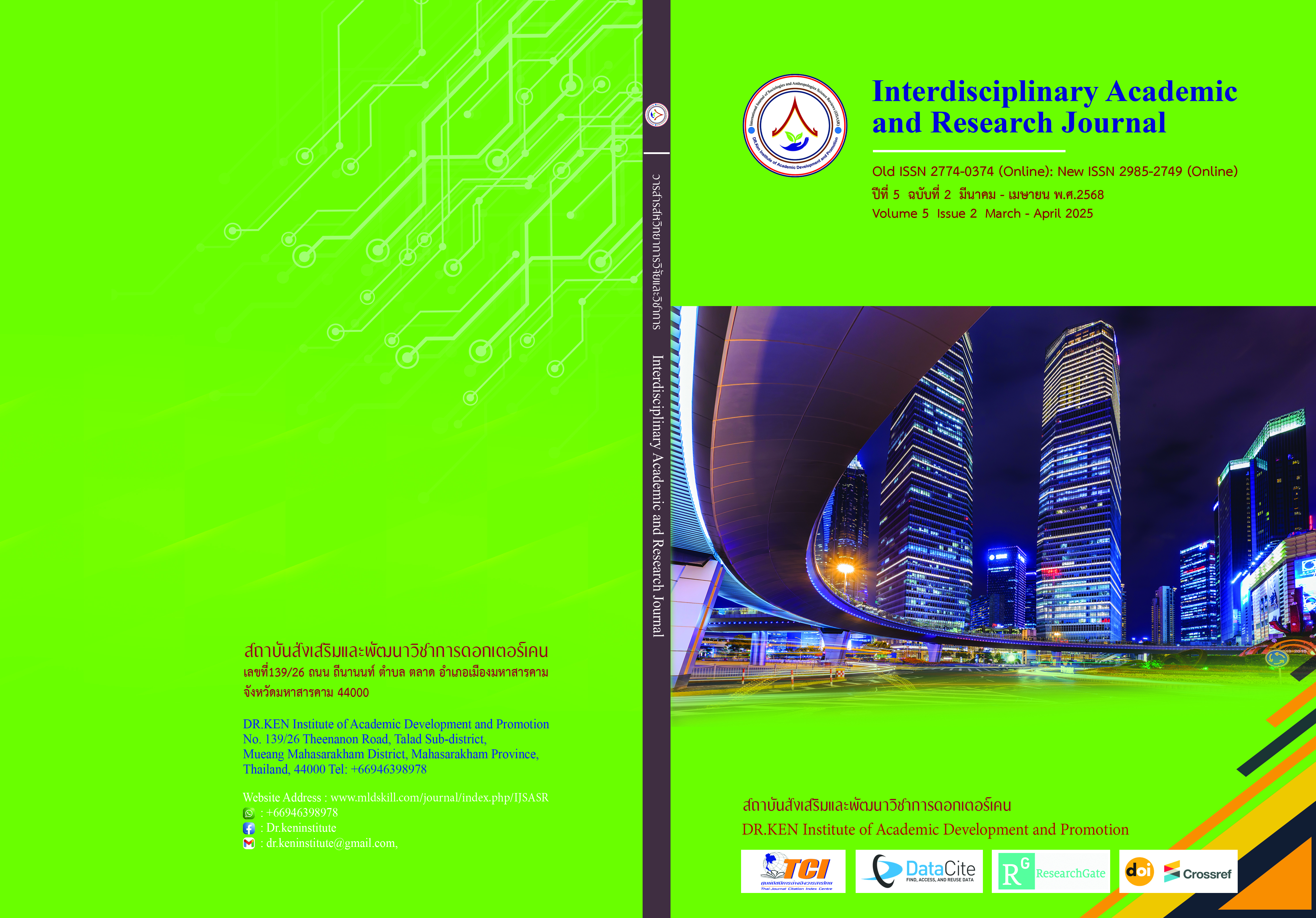Distributed Leadership and Human Capital Development Affecting High-Performance Organization of School
DOI:
https://doi.org/10.60027/iarj.2025.281368Keywords:
Distributed Leadership, Human Capital Development, High Performance OrganizationAbstract
Background and Aims: The aims of this study are as follows: (1) to study the levels of distributed leadership, the levels of human capital development, and the levels of high-performance organization of schools; (2) to examine the relationship between distributed leadership, human capital development, and high-performance organization of schools; (3) to study distributed leadership and human capital development on high-performance organization of schools. Methodology: The sample group consisted of 248 teachers from Bangkok Metropolitan Administration schools by multi-stage random sampling. The research instrument was a five-point Likert scale questionnaire with an IOC value of 0.50 or higher. The reliability value of the questionnaire was .974. The statistical analyses included percentage, mean, Pearson's correlation coefficient, and multiple regression.
Results: The findings revealed the following: (1) the overall levels of distributed leadership, human capital development, and high-performance organization of schools were high, and (2) distributed leadership and human capital development were correlated with high-performance organization of schools. Overall, the variables showed correlation coefficients ranging from .629 to .922, all with statistically significant relationships; and (3) distributed leadership and human capital development influenced the high-performance organization by 70.40% at the .001 level.
Conclusion: The findings show that distributed leadership and human capital development have a significant impact on school performance. These factors were responsible for 70.40% of the influence on school performance, with strong and statistically significant correlations.
References
กาญจนา ครูพิพรม. (2563). การพัฒนาทุนมนุษย์ในสถาบันอุดมศึกษา : กรณีศึกษามหาวิทยาลัยมหาสารคาม.วิทยานิพนธ์ปริญญามหาบัณฑิต, มหาวิทยาลัยมหาสารคาม. https://khoon.msu.ac.th/_dir/fulltext/2021/09/Karnjana%20Krupiprom63.pdf
คมคาย น้อยสิทธิ์, บุญเรียง ขจรศิลป, และ ธนีนาฏ ณ สุนทร. (2565). การพัฒนาองค์ประกอบตัวบ่งชี้และแบบประเมินภาวะผู้นําแบบกระจายอํานาจของผู้บริหารสถานศึกษาสังกัดสํานักงานเขตพื้นที่การศึกษาประถมศึกษาจังหวัดนนทบุรี. วารสารสันติศึกษาปริทรรศน์ มจร., 10(4), 1726-1737. https://so03.tci-thaijo.org/index.php/journal-peace/article/view/248969
จตุพร งามสงวน. (2560). รูปแบบการพัฒนาองค์การสมรรถนะสูงของโรงเรียนมัธยมศึกษาขนาดใหญ่พิเศษสังกัดสำนักงานคณะกรรมการการศึกษาขั้นพื้นฐาน. วิทยาานิพนธ์ปริญญาดุษฎีบัณฑิต, มหาวิทยาลัยราชภัฏนครสวรรค์.
ชูศรี วงศ์รัตนะ. (2553). เทคนิคการใช้สถิติเพื่อการวิจัย. กรุงเทพฯ: เทพเนรมิตการพิมพ์.
โชคชัย สุเวชวัฒนกูล, และ กนกกานต์ แก้วนุช. (2555). ทางเลือก-ทางรอดจากวิกฤตเศรษฐกิจของกิจกรรมทุนมนุษย์ในอุตสาหกรรมการท่องเที่ยวและบริการตามหลักปรัชญาเศรษฐกิจพอเพียง: กิจกรรมการบริหารและการพัฒนาทุนมนุษย. การประชุมวิชาการระดับชาติในวันคล้ายวันสถาปนาสถาบันบัณฑิตพัฒนบริหารศาสตร์ ประจำปี 2555.
ณัชญานุช สุดชาดี, ถนอมวรรณ ประเสริฐเจริญสุข, และ ทรงศักดิ์ ภูสีอ่อน. (2561). โมเดลสมการโครงสร้างภาวะผู้นำของผู้บริหารและพฤติกรรมองค์การที่ส่งผลต่อองค์การสมรรถนะสูง:การวิเคราะห์อิทธิพลผ่านตัวแปรคั่นกลาง. วารสารบริหารการศึกษา มหาวิทยาลัยขอนแก่น, 14(2), 67-77. https://so02.tci-thaijo.org/index.php/EDMKKU/article/view/178984/127163
ดวงเดือน ศิริโท, และ สมานจิต ภิรมย์รื่น. (2561). การพัฒนาทุนมนุษย์ตามหลักธรรมาภิบาลที่ส่งเสริมประสิทธิผล โรงเรียนเอกชนในภาคตะวันออกเฉียงเหนือ. วารสารบัณฑิตศึกษา มหาวิทยาลัยราชภัฏวไลยอลงกรณ์ ในพระบรมราชูปถัมภ์, 12(2), 58-67.
ธันวา วาทิตต์พันธ์. (2564). องค์ประกอบของโรงเรียนมัธยมศึกษาสมรรถนะสูง. วิทยานิพนธ์ปริญญาดุษฎีบัณฑิต, มหาวิทยาลัยศิลปากร. http://ithesis-ir.su.ac.th/dspace/bitstream/ 123456789/3795/1/60252905.pdf
ปาจรีรัตน์ อิงคะวะระ และ เพ็ญวรา ชูประวัติ. (2561). แนวทางการพัฒนาภาวะผู้นำแบบกระจายความเป็นผู้นำของผู้บริหารโรงเรียน สังกัดสำนักงานเขตพื้นที่การศึกษาประถมศึกษา. An Online Journal of Education. 14(2), 1905-4491.
พัชราพร ศิริพันธ์บุญ, และ กนกอร สมปราชญ์. (2560). ภาวะผู้นำแบบกระจายอำนาจที่ส่งผลต่อโรงเรียนสมรรถนะสูงของสถานศึกษาสังกัดสำนักงานเขตพื้นที่การศึกษาประถมศึกษาขอนแก่น เขต 1. Journal of Education Khon Kaen University, 11(3), 164-175. https://so02.tci-thaijo.org/index.php/EDGKKUJ/article/view/124352
เยาวเรศ ตระกูลวีระยุทธ. (2558). รูปแบบการบริหารสถานศึกษาขีดสมรรถนะสูง สังกัดองค์กรปกครองส่วนท้องถิ่น. วารสารบัณฑิตศึกษา มหาวิทยาลัยราชภัฏวไลยอลงกรณ์ ในพระบรมราชูปถัมภ์, 9(1), 12-25. สืบค้นจาก: https://so02.tci-thaijo.org/index.php/JournalGradVRU/article/view/32950/28035
วรลักษณ์ ลลิตศศิวิมล. (2559). แบบจำลองสมการโครงสร้างการพัฒนาทุนมนุษย์ที่ส่งผลต่อความได้เปรียบทางการแข่งขันเพื่อความสำเร็จในการดำเนินงานของธุรกิจเอกชนในจังหวัดสงขลา. วารสารบริหารธุรกิจเทคโนโลยีมหานคร, 13(2), 79-99. https://so04.tci-thaijo.org/ index.php/journalmbsmut/article/view/77284/62017
วิรัลพัชร นันทินบัณฑิต. (2563). การพัฒนาทุนมนุษย์ของโรงเรียนสังกัดเทศบาล. วิทยานิพนธ์ปริญญาดุษฎีบัณฑิต, มหาวิทยาลัยศิลปากร. http://ithesis-ir.su.ac.th/dspace/handle/123456789/3233
ศุภกานต์ ประเสริฐรัตนะ. (2555). โมเดลสมการโครงสร้างภาวะผู้นําแบบกระจายอํานาจของผู้บริหารสถานศึกษาขั้นพื้นฐาน. วิทยานิพนธ์ปริญญาดุษฎีบัณฑิต, มหาวิทยาลัยขอนแก่น. http://phd.mbuisc.ac.th/thesis/Supphakant.pdf
สำนักการศึกษา กรุงเทพมหานคร. (2566). รายงานสถิติปีการศึกษา 2566 โรงเรียนสังกัดกรุงเทพมหานคร. สำนักการศึกษา กรุงเทพมหานคร
สำนักงานคณะกรรมการกฤษฎีกา. (2546). พระราชบัญญัติสภาครูและบุคลากรทางการศึกษา พ.ศ. 2546. สำนักงานคณะกรรมการกฤษฎีกา.
สำนักงานคณะกรรมการพัฒนาระบบราชการ. (2557). เกณฑ์คุณภาพการบริหารจัดการภาครัฐ พ.ศ.2558. วิชั่นพริ้นท์แอนด์มีเดีย.
สำนักงานเลขาธิการสภาการศึกษา. (2560). แผนการศึกษาแห่งชาติ พ.ศ. 2560 – 2579. สืบค้นจาก: https://www.onec.go.th/index.php/book/BookView/1540. สำนักงานเลขาธิการสภาการศึกษา.
สำนักงานสภาพัฒนาการเศรษฐกิจและสังคมแห่งชาติ. (2565). แผนพัฒนาเศรษฐกิจและสังคมแห่งชาติ ฉบับที่ 13 (พ.ศ.2566-2570). สำนักงานสภาพัฒนาการเศรษฐกิจและสังคมแห่งชาติ.
Armstrong, M., & Murlis, H. (2007). Reward Management: A Handbook of Remuneration Strategy and Practice. 3rd Edition, Kogan Page Publishers, London.
Chatterji, N., & Kiran, R. (2017). Role of human and relational capital of universities as underpinnings of a knowledge economy: A structural modeling perspective from north Indian universities. International Journal of Educational Development, 56, 52-61.
Davis, M. (2009). Distributed leadership and school performance. Ph.D. Dissertation, Department of Education Leadership, University of The George Washington.
Elmore, R. (2000). Building a new structure for school leadership. Albert Shanker Institute.
Gordon, Z. V. (2005). The Effect of Distributed Leadership on Student Achievement. Central Connecticut State University. https://books.google.co.th/books?id=yZzuygAACAAJ
Grant, C. P. (2011). The relationship between distributed leadership and principal's leadership effectiveness in North Carolina. North Carolina State University.
Harris, A. (2016). Distributed leadership matters: perspectives, practicalities, and potential. Thousand Oaks, California: Corwin. Retrieved from: https://sk.sagepub.com/Books/distributed-leadership-matters
Kayrooz, C., & Leming, M.J. (2008). Distributed Leadership: Leadership in Context. UNESCO-APEID International Conference: Quality Innovations for Teaching and Learning.
Krejcie, R. V., & Morgan, D. W. (1970). Determining sample size for research activities. Educational and Psychological Measurement, 30(3), 607 – 610.
Leithwood, K., Mascall, B., Strauss, T., Sacks, R., Memon, N., & Yashkina, A. (2007). Distributing leadership to make schools smarter: Talking the ego out of the system. Leadership and Policy in schools, 6(1), 37-67.
MacBeath, J. (2005). Leadership as distributed: a matter of practice. School Leadership & Management, 25(4), 349-366.
Riddle II, P. L. (2015). The Relationship between the Distributed Leadership Readiness of West Virginia Principals and Their Perceptions of Selected School-based Committees. West Virginia University.
Smith, L. M. (2007). A study of teacher engagement in four dimensions of distributed leadership in one school district in Georgia. Ph.D. Dissertation, Department of Education Leadership, University of Georgia Southern.
Terrell, H. P. (2010). The relationship of the dimensions of distributed leadership in elementary schools of urban districts and student achievement. Dissertation Abstracts International Section A: Humanities and Social Sciences, 71(4-A), 1159.
Texas Education Agency. (2016). 2015-2016 Reward Schools Case Studies: Statewide Report. Texas Comprehensive Center.
Downloads
Published
How to Cite
Issue
Section
License
Copyright (c) 2025 Interdisciplinary Academic and Research Journal

This work is licensed under a Creative Commons Attribution-NonCommercial-NoDerivatives 4.0 International License.
Copyright on any article in the Interdisciplinary Academic and Research Journal is retained by the author(s) under the under the Creative Commons Attribution-NonCommercial-NoDerivatives 4.0 International License. Permission to use text, content, images, etc. of publication. Any user to read, download, copy, distribute, print, search, or link to the full texts of articles, crawl them for indexing, pass them as data to software, or use them for any other lawful purpose. But do not use it for commercial use or with the intent to benefit any business.














.png)

